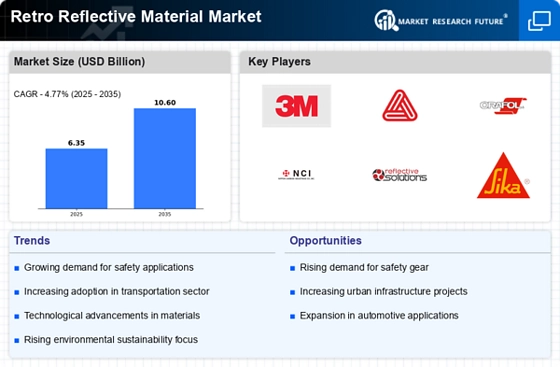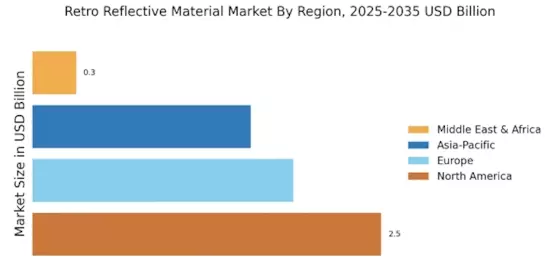Rising Awareness of Road Safety
The Retro Reflective Material Market is experiencing growth driven by the rising awareness of road safety among the general public and authorities. Increased incidents of road accidents have prompted governments and organizations to implement stricter regulations regarding visibility standards for vehicles and road signage. This heightened focus on safety is leading to greater adoption of retro reflective materials in various applications, including road markings and safety gear. Recent surveys indicate that public awareness campaigns are effectively educating individuals about the importance of visibility in preventing accidents. As a result, the retro reflective material market is likely to see a sustained increase in demand, as stakeholders prioritize safety measures to protect both pedestrians and drivers.
Increasing Demand in Safety Apparel
The Retro Reflective Material Market is experiencing a notable surge in demand for safety apparel, particularly in sectors such as construction, transportation, and emergency services. This increase is largely driven by heightened awareness of workplace safety regulations and the necessity for visibility in hazardous environments. According to recent data, the market for safety apparel incorporating retro reflective materials is projected to grow at a compound annual growth rate of approximately 6.5% over the next five years. This trend indicates a robust commitment to enhancing worker safety, thereby propelling the retro reflective material market forward. As industries prioritize protective gear, the integration of retro reflective materials becomes essential, ensuring that personnel remain visible in low-light conditions, thus reducing the risk of accidents.
Expansion in Automotive Applications
The Retro Reflective Material Market is witnessing significant growth due to its expanding applications in the automotive sector. With the increasing focus on road safety and vehicle visibility, retro reflective materials are being utilized in various automotive components, including license plates, signage, and vehicle markings. Recent statistics suggest that the automotive segment accounts for a substantial share of the retro reflective material market, with projections indicating a growth rate of around 5% annually. This expansion is further fueled by advancements in material technology, which enhance the performance and durability of retro reflective products. As automotive manufacturers strive to meet stringent safety standards, the demand for high-quality retro reflective materials is likely to escalate, thereby driving the overall market growth.
Growth in Infrastructure Development
The Retro Reflective Material Market is significantly influenced by the ongoing growth in infrastructure development projects worldwide. As urbanization accelerates, the need for effective traffic management and safety measures becomes increasingly critical. Retro reflective materials are extensively used in road signage, lane markings, and construction barriers to enhance visibility and safety. Recent reports indicate that infrastructure investments are expected to reach trillions of dollars over the next decade, creating a substantial opportunity for retro reflective material suppliers. This trend suggests that as governments and private entities prioritize infrastructure improvements, the demand for retro reflective materials will likely rise, contributing to the overall expansion of the market.
Technological Innovations in Material Science
The Retro Reflective Material Market is benefiting from ongoing technological innovations in material science. Advances in the development of new retro reflective materials, such as microprismatic and glass bead technologies, are enhancing the performance characteristics of these products. These innovations not only improve visibility but also increase durability and resistance to environmental factors. As a result, manufacturers are able to offer superior products that meet the evolving needs of various industries. The introduction of smart materials that can adapt to changing light conditions is also on the horizon, potentially revolutionizing the retro reflective material market. This continuous evolution in material technology is likely to drive market growth as industries seek to adopt the latest advancements for improved safety and efficiency.


















Leave a Comment